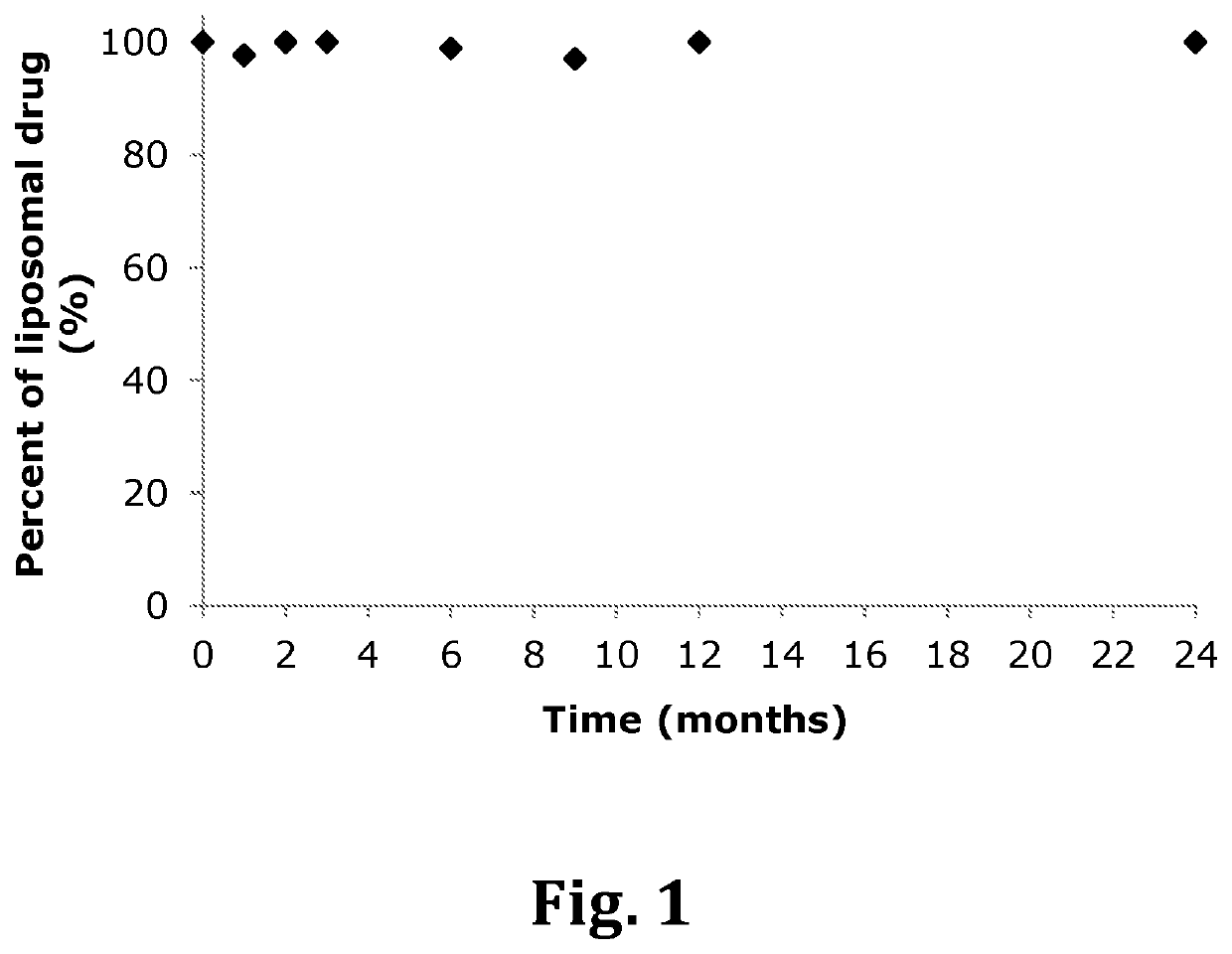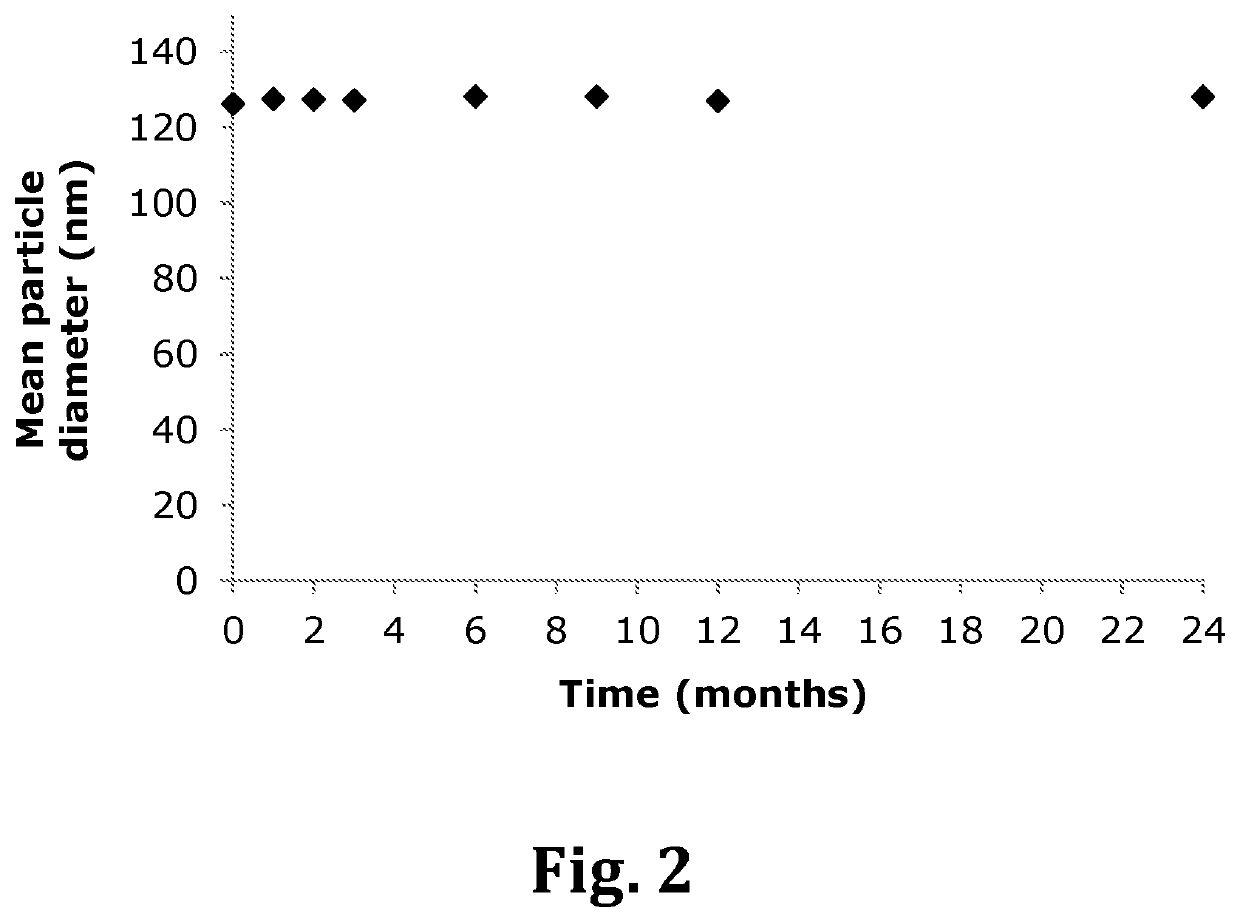Inhalable liposomal sustained release composition for use in treating pulmonary diseases
a pulmonary disease and composition technology, applied in the direction of drug compositions, dispersed delivery, heterocyclic compound active ingredients, etc., can solve the problems of tyrosine kinase, poor prognosis of pulmonary disease, devastating prognosis and debilitating symptoms with limited treatment options, etc., to achieve enhanced treatment of pulmonary disease, sustained drug release, and low drug dose
- Summary
- Abstract
- Description
- Claims
- Application Information
AI Technical Summary
Benefits of technology
Problems solved by technology
Method used
Image
Examples
example 1
Preparation of Liposomal Tyrosine Kinase Inhibitor (TKI)
I. Preparation of Empty Liposomes
[0077]Liposomes were prepared via the thin-film hydration method or solvent injection method. The process for preparing empty liposomes by thin-film hydration method comprises the following steps:[0078]1. weighing out a lipid mixture of phospholipids and cholesterol at a predetermined molar ratio either in the presence or absence of DSPE-PEG2000 and adding the lipid mixture to 10 mL of chloroform in a round-bottom flask;[0079]2. placing the flask in a rotary evaporator at 60° C. and stirring the flask to dissolve the lipid mixture, followed by putting the flask under vacuum while stirring to evaporate the chloroform to obtain a dried lipid film;[0080]3. preparing a trapping agent solution (e.g., ammonium sulfate (A.S.)) by adding a trapping agent to 5 mL of distilled water and vortexing the solution to dissolve the powder;[0081]4. adding the trapping agent solution to the dried lipid film and st...
example 2
Entrapment of TKI in Liposome
[0094]Embodied TKI, nintedanib, was loaded into empty liposomes with a mean particle diameter of approximately 120 nm and comprising various phospholipids (e.g., HSPC, DSPC, DSPC / DPPE, or combinations thereof), with 300 mM A.S. as the trapping agent, and the indicated content of PEG-modified phospholipid (e.g., 0.9 mol % DSPE-PEG2000) according to the method described in Example 1, section II.
[0095]Table 3 summarizes the nintedanib encapsulation results for these active loading experiments. The 300 mM A.S. empty liposomes comprising 0.9 mol % PEG-modified lipid encapsulated a D / L ratio of at least 0.9 mol / mol of nintedanib, regardless of the PC lipids or combination of PC / PE lipids in the empty liposome formulation. Therefore, for liposomes comprising the same trapping agent (ammonium sulfate) and PEG content, there is flexibility in choosing different phospholipids for an inhalable liposomal nintedanib formulation that can achieve high drug encapsulatio...
example 3
Effect of Empty Liposome Size on the Stability of Nebulized Liposomal TKI
[0096]The stability of liposomal TKI after nebulization was investigated for liposomal drugs of varying particle sizes for formulations of low PEG content with high encapsulation of nintedanib. Different sized liposomes were prepared by extrusion of hydrated lipids through polycarbonate membranes of varying pore sizes (0.1 μm, 0.2 μm, 0.4 μm, and 1 μm) prior to remote loading of nintedanib into said liposomes. The liposome formulation used for the nebulization stability tests had a composition of HSPC:cholesterol:DSPE-PEG2000 at a molar ratio of 3:2:0.045 with 300 mM A.S. as the trapping agent. The protocol for nebulization of the liposomal TKI sample was as follows:[0097]1. add 2 mL of liposomal drug to the medication chamber of a Vib-Mesh Nebulizer HL100 (commercialized by Health and Life Corporation);[0098]2. slide in and connect the medication chamber to the rest of the nebulizer;[0099]3. turn on the nebuli...
PUM
| Property | Measurement | Unit |
|---|---|---|
| mean particle diameter | aaaaa | aaaaa |
| mean particle diameter | aaaaa | aaaaa |
| concentration | aaaaa | aaaaa |
Abstract
Description
Claims
Application Information
 Login to View More
Login to View More - R&D
- Intellectual Property
- Life Sciences
- Materials
- Tech Scout
- Unparalleled Data Quality
- Higher Quality Content
- 60% Fewer Hallucinations
Browse by: Latest US Patents, China's latest patents, Technical Efficacy Thesaurus, Application Domain, Technology Topic, Popular Technical Reports.
© 2025 PatSnap. All rights reserved.Legal|Privacy policy|Modern Slavery Act Transparency Statement|Sitemap|About US| Contact US: help@patsnap.com



